MacOS 13 Ventura is Apple's desktop operating system for Macintosh computers and is the 19th major release. On June 6, 2022, Apple introduced the successor to MacOS Monterey at WWDC 2022. It follows the home-based naming system that debuted with OSX Mavericks and is named after the city of Ventura, California.
The public beta will be accessible in July after the release of the first development version on June 6, 2022. Additionally, the final version will be available by the end of 2022.
For users who cannot wait for the public MacOS 13 Ventura version, you have to access it as a developer, and here is how.
Now, Apple’s latest feature update, macOS Sequoia 15.0, released on September 16, 2024, has been one of the most anticipated ones.
MacOS 13 Ventura Availability
Here are the Mac systems that the MacOS 13 Ventura is compatible with;
- iMac – 2017 and later
- Mac Studio – 2022
- Mac Pro – 2019 and later
- iMac Pro – 2017 and later
- Mac mini – 2018 and later
- MacBook Air – 2018 and later
- MacBook – 2017 and later
- MacBook Pro – 2017 and later
Part 1. Before Upgrading to MacOS Ventura
First and foremost, you must protect your data before installing beta software on your device. It would help if you didn't jump on board without understanding the risks because beta software is notoriously problematic and can result in difficulties such as bricking, overheating, and even data loss. As a result, make a backup of your Mac before proceeding with the procedure.
If something goes wrong, you may restore your data and even downgrade to macOS 12 from macOS 13 using the latest macOS backup.
- Cloning your hard drive
- Uploading all your data to a cloud
- Using Time Machine.
3 Simple Methods to Back up Mac
Part 2. How to Download and Install MacOS 13 Ventura on your Mac?
Users should know that to enjoy this experience, you have to become an Apple developer or wait for the public beta version.
How to be an Apple Developer?
1. Go to the program's page. At developer.apple.com, click the Account button marked below.
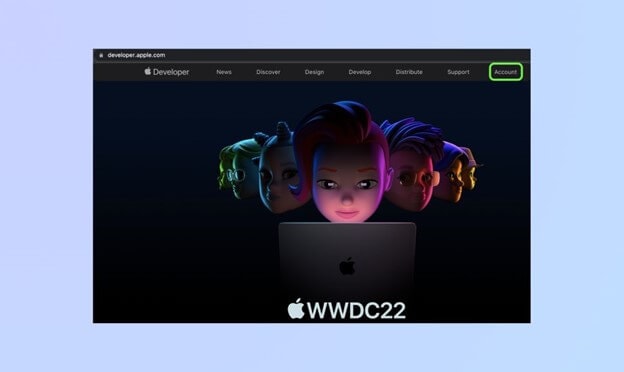
2. Create a new Apple ID for this business by clicking "Create yours now" below on the Sign in to Apple Developer page.
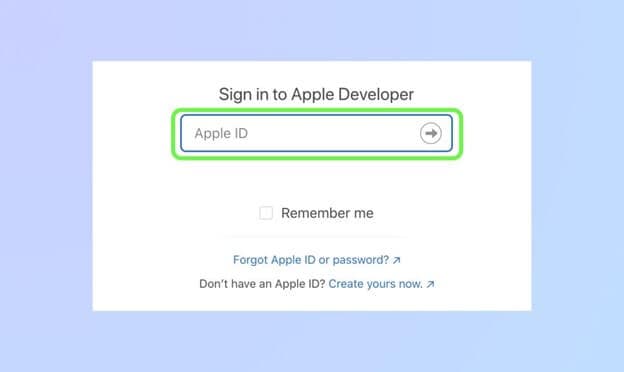
3. Fill out the form to create your new Apple ID.
4. Check the validity of your new Apple ID. You must first validate your email and then your mobile device.
5. Accept the Apple Developer Agreement after that.
6. Click "Join the Apple Developer Program" towards the bottom of the page.
7. Select "Enroll" on the next page
8. You'll be asked for some personal information on the next page so Apple can verify your identity.
9. Continue to the following page, where Apple will ask you to select your entity type after you've supplied this information.
10. After choosing your registration, it'll take you to the Apple Developer Program License Agreement page, where you can review and agree on the terms before proceeding to the payment confirmation page. This page contains your license number and confirmation of the payment owed.
Get Ready to Download and Install MacOS 13 Ventura Beta
1. First, open your Mac's browser and go to developer.apple.com.
2. Sign in to your developer account by clicking the "Account" link.
3. Then, in the left sidebar, select "Downloads."

4. Select "Install Profile" from the drop-down menu after scrolling down to the "macOS 13 beta" section.
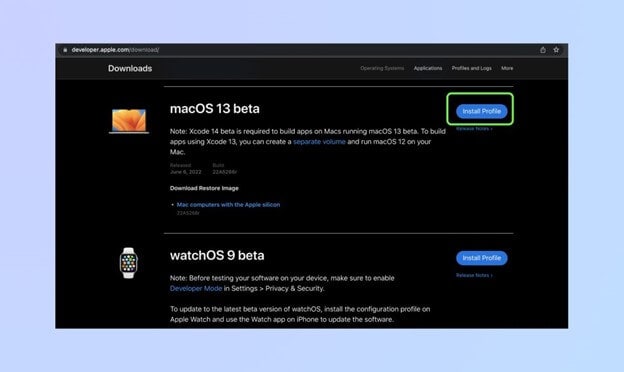
5. A pop-up window will appear on the screen. Select Allow from the drop-down selection to continue.
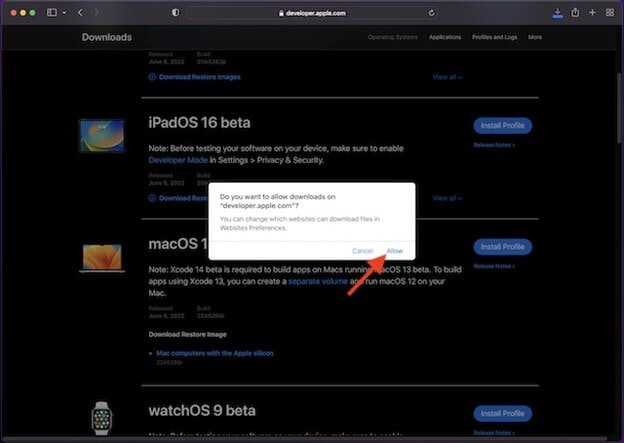
6. Then, enter the "Downloads" folder in Finder and choose macOS 13DeveloperBetaAccessUtility.
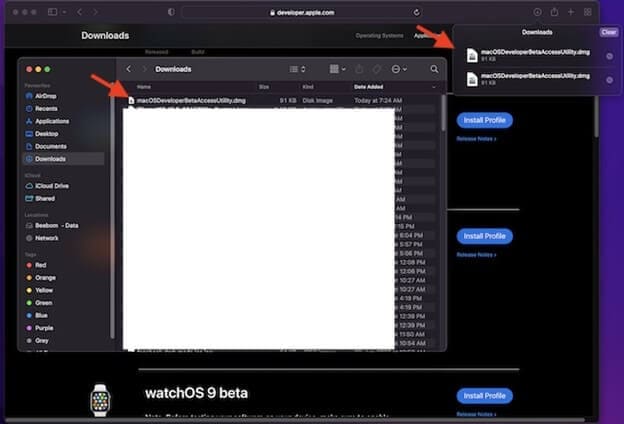
7. Double-click the macOS Ventura developer beta installer to execute the macOSDeveloperBetaAccessUtility.pkg file.
8. Ensure that you accept Apple's terms and conditions.
9. Then, to complete the installation, follow the on-screen instructions. To download macOS Ventura, you must first enter your administrator password and click "Install Software."
10. To continue, click "Continue" in the macOS Ventura beta installer.
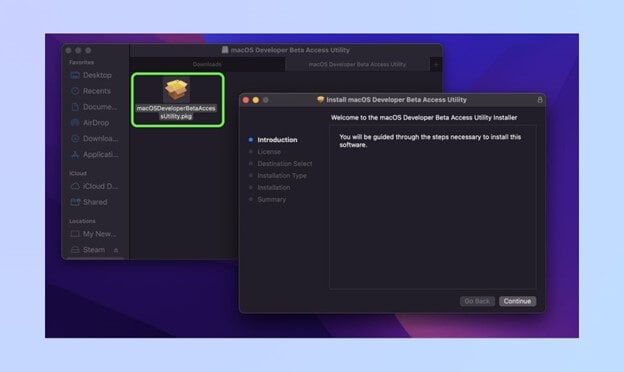
11. Accept Apple's Terms and Conditions now.
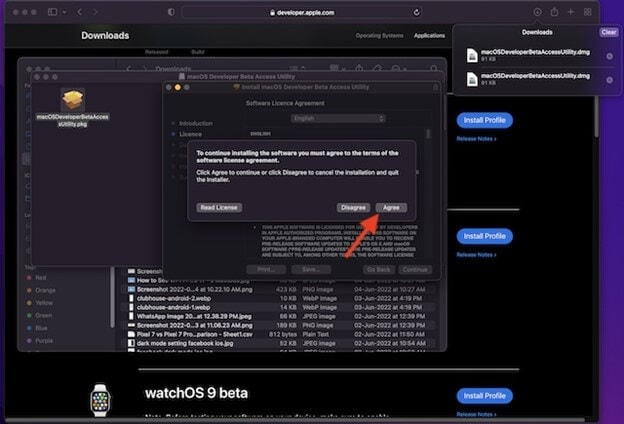
12. Finally, to begin installing macOS Ventura on your Mac, click "Install" and follow the instructions.
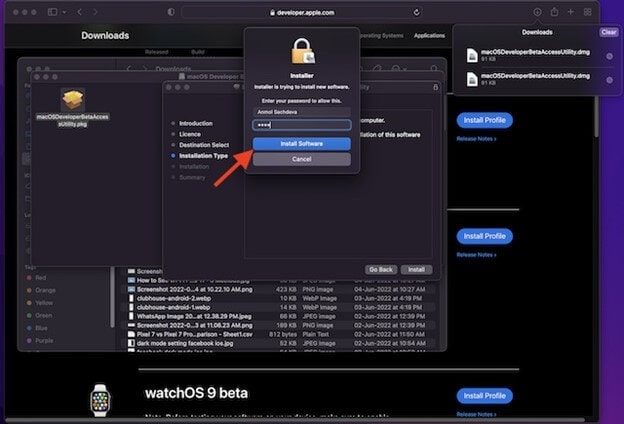
13. You'll be prompted to restart your Mac after the installation is complete. Press the Restart button.
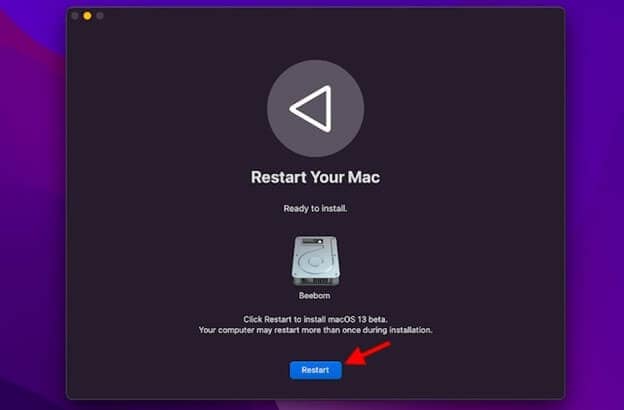
Video Tutorial on How to install macOS 13 Ventura on PC?
Part 3. Alternative to Try MacOS Ventura by Updating Your Service
A software's beta version is prone to bugs and other difficulties. To keep your data safe, install the beta on a backup device or create a partition in your Mac's storage. Here is how to install Ventura on a system partition.
- After downloading, go to the installation window and select Continue.
- Confirm your agreement by clicking Agree.
- Now, pick the partition by pressing Show All Disks.
- To begin the installation, click Install.

How to Download the MacOS Ventura Beta and Install on a Disk Partition?
We've provided you with the traditional method of downloading and installing MacOS 13 Ventura on your Mac. However, another method allows you to prevent your crucial data from getting corrupted by the Ventura Beta. Most people prefer to wipe their Mac clean and get started, but this includes letting go of your file. Creating a partition allows you to run the new MacOS while still using your current Mac OS.
- A partition is the best option for you because you can try the Mac OS 13 Ventura while it's still in the beta stage without letting go of your current OS. Below are the steps to help you install MacOS on a new hard drive.
- Firstly, open 'disk utility' and select your hard drive to proceed.
- Next, select the partition tab and add a new partition; you can choose to customize the size before you click 'apply.'
- Now, download the MacOS Ventura installer on your device and click 'install' to start the installation process.
- Click 'continue' in the installation process and agree to its terms and services.
- Now choose 'show all disks' to select the partition you want to install on.
- After choosing, click install.
- The installation helper will transfer information from your current operating system. Alternatively, you can opt for a clean installation to start using the new operating system from scratch.
Part 4. How to Get Started with MacOS 13 Ventura?
The new macOS 13 wallpaper and lock screen will greet you when your Mac restarts. After that, it's time to configure your Mac and personalize the new features to your preferences.
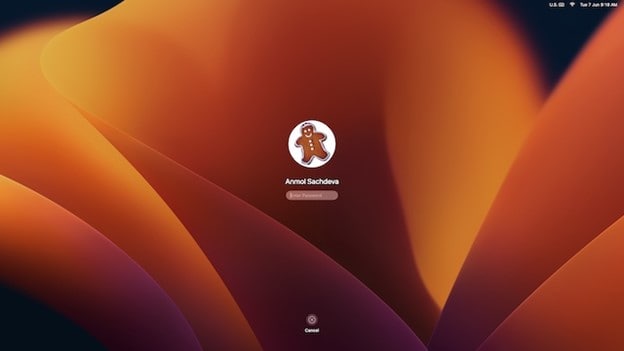
Explore New Features
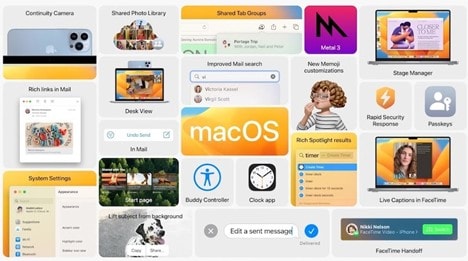
Go ahead and explore all of the amazing features and hidden secrets in Apple's latest desktop OS upgrade now that you've got your hands on macOS 13 beta. Of course, you'll enjoy macOS Ventura, which includes several critical new add-ons. Testing has begun on the most recent version of macOS, particularly the Stage Manager feature, so you can expect more out of Ventura.
Here are a few new features;
Stage Manager
This is a new feature that's coming with the MacOS Ventura 13. It automatically organizes the windows and apps on your Mac to a single view. This simplifies the use of your PC by making it easy for your to switch between different tasks. The Stage manager also allows you to create different groups of apps that you use for various tasks.
Continuity Camera
This is another exciting feature we're looking forward to on the MacOS Ventura. When you bring the iPhone close to your Mac, the Mac would switch to the iPhone as its camera input and work wirelessly. It also features a center stage that allows you to utilize the ultra-wide sensor on the iPhone.
The mail also comes with several updates in the MacOS Ventura 13 beta. This includes a more accurate search for your messages. We also love that it now features an 'undo send button'. The 'schedule send' feature reminds you to follow up if you didn't get a reply to your mail and the app thinks that you're expecting a response.
Spotlight
Spotlight is another feature that comes with this new Ventura Beta. It provides users with an enhanced image search. This allows users easily locate messages, Finder, Photos, Web straight, and notes from Spotlight. You can also utilize the live text feature to look for an image based on the text located within it. In addition, you'll be able to utilize quick actions that allow you to do things like starting a direct focus or setting the alarm.
For Windows XP/Vista/7/8/10/11
For macOS X 10.10 or later

 ChatGPT
ChatGPT
 Perplexity
Perplexity
 Google AI Mode
Google AI Mode
 Grok
Grok























